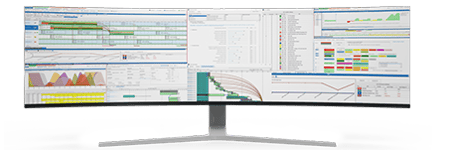
Overcoming the Bullwhip Effect in Production Plans
In food and beverage manufacturing, maintaining an efficient and responsive production plan is crucial to staying competitive. However, one persistent challenge that continues to plague supply chains is the bullwhip effect. This phenomenon, characterized by increasing variability in demand forecasts as they move upstream in the supply chain, can lead to inefficiencies, excessive inventory, and disrupted production schedules.
For plant managers, the bullwhip effect isn’t just a theoretical concept—it has tangible impacts on day-to-day operations, costs, and customer satisfaction. Fortunately, modern technological solutions, such as the integration of advanced planning and scheduling (APS) tools like PlanetTogether with enterprise resource planning (ERP) systems like SAP, Oracle, Microsoft Dynamics, Kinaxis, or Aveva, can help mitigate these challenges.
In this blog, we’ll explore the bullwhip effect, its impact on production planning, and how the right technology can turn the tide.

Understanding the Bullwhip Effect
The bullwhip effect occurs when small fluctuations in customer demand at the retail level lead to larger and larger swings in production and inventory levels as they move upstream in the supply chain. For food and beverage manufacturers, these fluctuations can be particularly problematic due to factors such as:
Short Shelf Life of Products: Excess inventory often leads to waste, especially in perishable goods.
High Sensitivity to Consumer Trends: Demand shifts caused by seasonality or health trends amplify the effect.
Complexity in Ingredients and Packaging: Small changes in demand ripple across a network of suppliers, leading to inefficiencies.
The result? Overproduction, underutilized resources, stockouts, and inflated costs.

The Role of Accurate Production Planning
The key to overcoming the bullwhip effect lies in reducing demand variability and improving supply chain visibility. As a plant manager, you have a pivotal role in ensuring that production plans align with actual demand rather than reactive forecasts. This requires:
Real-time Visibility: Understanding inventory levels, production capacity, and supplier constraints.
Collaboration Across the Supply Chain: Sharing accurate and timely data with suppliers and distributors.
Scenario Planning: Being prepared for unexpected demand surges or disruptions.
However, achieving this level of coordination is easier said than done without the right tools.


Leveraging Technology to Tame the Bullwhip Effect
Integrating PlanetTogether APS with ERP systems such as SAP, Oracle, Microsoft Dynamics, Kinaxis, or Aveva provides a robust foundation for tackling the bullwhip effect. Here’s how:
Improved Demand Forecasting
PlanetTogether integrates seamlessly with ERP systems to provide real-time demand data. For instance:
SAP’s advanced analytics capabilities combined with PlanetTogether’s scheduling algorithms enable demand forecasts to be updated dynamically, reducing variability.
Oracle’s cloud-based supply chain tools offer predictive insights, which, when paired with PlanetTogether, ensure that production plans are both agile and precise.
Enhanced Collaboration Across the Supply Chain
Through integration, data silos are broken down, enabling better communication between suppliers, manufacturers, and distributors. For example:
Kinaxis’s RapidResponse platform allows for synchronized planning and execution, while PlanetTogether ensures production schedules remain optimized for current demand.
Real-time Production Adjustments
The food and beverage industry often faces unexpected disruptions such as ingredient shortages or equipment failures. Integration allows for real-time adjustments:
Microsoft Dynamics and PlanetTogether together provide a unified platform to reschedule production runs instantly based on live updates from the shop floor.
Optimized Inventory Levels
Overstocking and understocking are common symptoms of the bullwhip effect. Integrated systems help maintain optimal inventory:
With Aveva’s predictive maintenance tools feeding data into PlanetTogether, production plans can account for machinery performance, minimizing downtime and ensuring steady output.

Implementation Steps for Plant Managers
Integrating PlanetTogether with an ERP system might seem like a daunting task, but it’s a worthwhile investment. Here’s a step-by-step guide:
Assess Your Current System: Identify gaps in your production planning process. Are you struggling with demand variability or communication breakdowns?
Choose the Right ERP Partner: Evaluate systems like SAP, Oracle, Microsoft Dynamics, Kinaxis, or Aveva based on your facility’s specific needs.
Engage Stakeholders: Collaboration between IT, operations, and supply chain teams is critical to a successful implementation.
Invest in Training: Ensure your team understands how to leverage integrated tools effectively.
Monitor and Optimize: Use analytics to continuously refine production plans and supply chain strategies.
As consumer expectations evolve, so too must your production planning strategies. The integration of PlanetTogether with ERP systems offers a powerful solution for overcoming the bullwhip effect in food and beverage manufacturing. By improving visibility, enhancing collaboration, and enabling real-time adjustments, you can ensure your facility operates efficiently and sustainably.
For plant managers, the path forward is clear: embrace technology, foster collaboration, and stay agile. By doing so, you’ll not only tame the bullwhip effect but also position your facility as a leader in the competitive food and beverage industry.
The bullwhip effect may be a long-standing challenge, but with the right tools and strategies, it’s one you can overcome. Are you ready to take your manufacturing operations to the next level? Contact us today to learn more about how PlanetTogether can help you achieve your goals and drive success in your industry.




